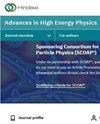有限磁场下重夸子s波和p波态的各向异性行为
IF 1.1
4区 物理与天体物理
Q3 PHYSICS, PARTICLES & FIELDS
引用次数: 0
摘要
利用扩展磁化有效逸度准粒子模型(EQPM)研究了动量空间各向异性对重夸克态的影响。电势的实部和虚部都通过介电函数进行了修正,其中包括各向异性参数ξ。在各向异性和恒定磁场的作用下,介质修饰电位的实部更具吸引力。研究了椭球和各向同性情况下1S、2S和1P夸克态的结合能,包括各向异性效应。我们发现Q Q¯态的结合能在各向异性的存在下变得更强。然而,发现磁场降低了结合能。研究了在恒磁场e B = 0.3 G e V 2条件下,各向同性和长向态的夏铵态和底铵态的热宽度。本文还研究了磁场对扁圆情况下1P态质谱的影响。与各向同性的情况相比,扁圆的情况下,正铵和底铵的1S、2S和1P态的解离温度要高。本文章由计算机程序翻译,如有差异,请以英文原文为准。
Anisotropic Behavior of S-Wave and P-Wave States of Heavy Quarkonia at Finite Magnetic Field
We studied the effect of momentum space anisotropy on heavy quarkonium states using an extended magnetized effective fugacity quasiparticle model (EQPM). Both the real and imaginary part of the potential has been modified through the dielectric function by including the anisotropic parameter
ξ
. The real part of the medium-modified potential becomes more attractive in the presence of the anisotropy and constant magnetic field. The binding energy of the 1S, 2S, and 1P quarkonium states including anisotropy effects for both the oblate and the isotropic case were studied. We find that the binding energy of
Q
Q
¯
states becomes stronger in the presence of anisotropy. However, the magnetic field is found to reduce the binding energy. The thermal width of the charmonium and bottomonium
1
S
states has been studied at constant magnetic field
e
B
=
0.3
G
e
V
2
for isotropic and prolate cases. The effect of magnetic field on the mass spectra of the 1P state for the oblate case was also examined. The dissociation temperature for the 1S, 2S, and 1P states of charmonium and bottomonium has been determined to be higher for the oblate case with respect to the isotropic case.
求助全文
通过发布文献求助,成功后即可免费获取论文全文。
去求助
来源期刊

Advances in High Energy Physics
PHYSICS, PARTICLES & FIELDS-
CiteScore
3.40
自引率
5.90%
发文量
55
审稿时长
6-12 weeks
期刊介绍:
Advances in High Energy Physics publishes the results of theoretical and experimental research on the nature of, and interaction between, energy and matter. Considering both original research and focussed review articles, the journal welcomes submissions from small research groups and large consortia alike.
 求助内容:
求助内容: 应助结果提醒方式:
应助结果提醒方式:


